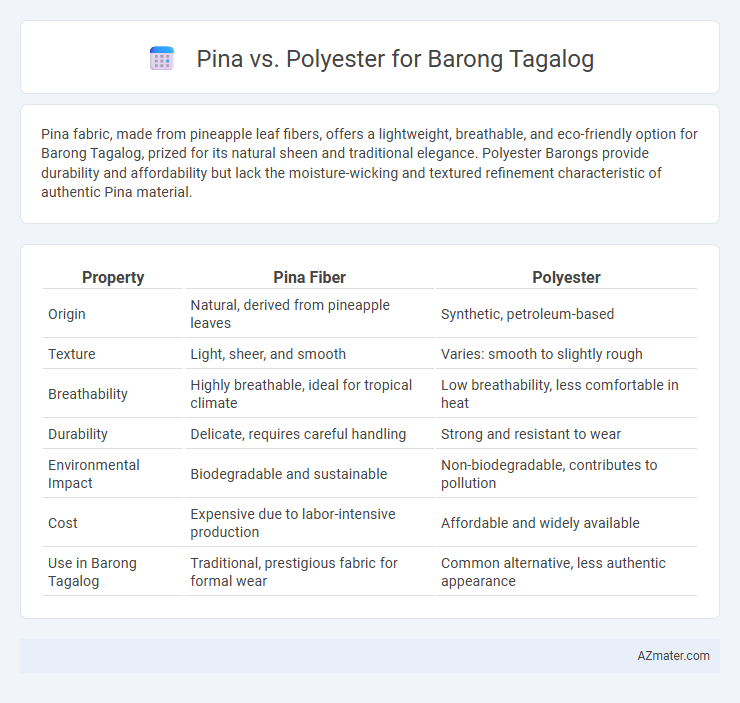Pina fabric, made from pineapple leaf fibers, offers a lightweight, breathable, and eco-friendly option for Barong Tagalog, prized for its natural sheen and traditional elegance. Polyester Barongs provide durability and affordability but lack the moisture-wicking and textured refinement characteristic of authentic Pina material.
Table of Comparison
| Property | Pina Fiber | Polyester |
|---|---|---|
| Origin | Natural, derived from pineapple leaves | Synthetic, petroleum-based |
| Texture | Light, sheer, and smooth | Varies: smooth to slightly rough |
| Breathability | Highly breathable, ideal for tropical climate | Low breathability, less comfortable in heat |
| Durability | Delicate, requires careful handling | Strong and resistant to wear |
| Environmental Impact | Biodegradable and sustainable | Non-biodegradable, contributes to pollution |
| Cost | Expensive due to labor-intensive production | Affordable and widely available |
| Use in Barong Tagalog | Traditional, prestigious fabric for formal wear | Common alternative, less authentic appearance |
Introduction to Barong Tagalog Fabrics
Barong Tagalog fabrics primarily feature Pina and Polyester, each representing distinct qualities and cultural significance. Pina, derived from pineapple leaf fibers, offers a delicate, translucent texture with natural sheen, praised for its breathability and traditional craftsmanship in Filipino heritage attire. Polyester, on the other hand, provides durability, wrinkle resistance, and affordability, making it a practical choice for everyday wear while lacking the authentic elegance inherent in Pina fabric.
Overview of Piña Fabric
Pina fabric, derived from pineapple leaf fibers, is a traditional and luxurious material used for Barong Tagalog, prized for its lightweight, sheer texture, and natural sheen. Known for its breathability and delicate embroidery compatibility, Pina offers superior comfort and elegance compared to polyester, which is synthetic and less breathable. The sustainable and eco-friendly nature of Pina enhances its appeal for authentic, high-quality Barong Tagalog garments.
Overview of Polyester Fabric
Polyester fabric, a synthetic fiber derived from petroleum, offers high durability, wrinkle resistance, and ease of care, making it a popular choice for Barong Tagalog. Its affordability and ability to mimic traditional fibers like Pina without the delicate maintenance appeal to everyday wearers and mass production. However, polyester lacks the natural breathability and luxurious texture that Pina fabric provides, often resulting in less comfort in tropical climates.
Historical Significance: Piña in Barong Tagalog
Pina fabric holds deep historical significance in Barong Tagalog, symbolizing Filipino heritage and artisanal craftsmanship dating back to the Spanish colonial era. Renowned for its delicate, translucent texture derived from pineapple leaf fibers, Pina was traditionally handwoven by Filipino weavers, making it a luxurious and culturally authentic choice for formal attire. Polyester, while more affordable and durable, lacks the historical resonance and intricate artistry that defines Pina as a timeless emblem of Filipino identity.
Affordability: Piña vs Polyester
Pina fabric, derived from pineapple leaf fibers, is significantly more expensive than polyester due to its labor-intensive production and limited supply. Polyester, a synthetic fiber, offers a highly affordable alternative with mass production and durability, making it accessible for everyday Barong Tagalog wear. Choosing polyester for affordability provides cost savings but sacrifices the luxurious texture and cultural authenticity associated with traditional pina fabric.
Comfort and Breathability Comparison
Pina fabric, derived from pineapple leaf fibers, offers exceptional breathability and lightweight comfort, ideal for the tropical climate where Barong Tagalog is traditionally worn. Polyester, a synthetic fabric, lacks natural airflow and tends to trap heat and moisture, reducing overall comfort during extended wear. The inherent moisture-wicking and air-permeable properties of Pina make it a superior choice for maintaining coolness and comfort compared to the less breathable polyester alternatives.
Durability and Maintenance: Which Lasts Longer?
Pina fabric, crafted from pineapple leaf fibers, offers delicate texture but requires careful maintenance to prevent damage, making it less durable for frequent wear compared to polyester. Polyester, a synthetic fabric, boasts high durability, resistance to wrinkles, and easy maintenance, making Barong Tagalog made from it last longer under regular use. Choosing polyester ensures greater longevity and simpler care, while Pina fabric demands gentle handling to preserve its intricate design and natural fibers.
Visual Appeal: Texture and Sheen
Pina fabric offers a unique translucent texture with a natural sheen that enhances the intricate embroidery of the Barong Tagalog, creating an elegant and refined visual appeal. Polyester, while more affordable and durable, often lacks the delicate translucency and subtle luster of Pina, resulting in a less authentic appearance. The fine texture and light-reflective quality of Pina make it the preferred choice for formal and traditional Barong Tagalog designs.
Sustainability and Environmental Impact
Pina fabric, derived from pineapple leaf fibers, offers a highly sustainable option for Barong Tagalog due to its renewable resource base and biodegradable nature, reducing environmental pollution. Polyester, a synthetic material made from petroleum, presents significant environmental challenges including non-biodegradability, high energy consumption in production, and microplastic pollution. Choosing Pina fabric supports eco-conscious fashion by minimizing carbon footprint and promoting the use of natural fibers in traditional Filipino garments.
Choosing the Best Fabric for Your Barong Tagalog
Pina fabric offers an elegant, lightweight texture with natural breathability perfect for formal Barong Tagalog, while polyester provides durability and affordability but lacks the luxurious feel and moisture-wicking properties of natural fibers. Choosing pina ensures authenticity and comfort, especially in hot climates, making it ideal for special occasions, whereas polyester suits budget-conscious buyers seeking easy maintenance. Opt for pina when prioritizing cultural heritage and premium quality, and polyester for practicality and lower cost without sacrificing the Barong's classic silhouette.

Infographic: Piña vs Polyester for Barong tagalog
 azmater.com
azmater.com